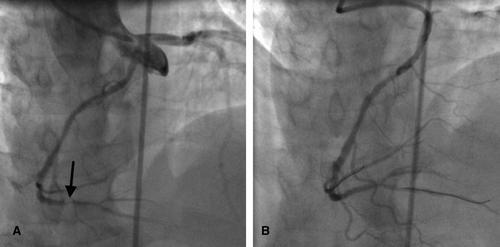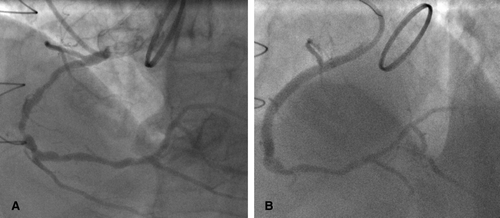Abstract
Right coronary arteries with anomalous origin (ARCA) may be associated with myocardial ischemia and sudden death. Selective catheterization and percutaneous coronary intervention (PCI) of ARCA can be technically challenging due to their slit-like orifice and aortic intramural course with abrupt angulation. The 3DRCA guide catheter is a unique catheter with a helical configuration that provides optimal guide support during PCI. We describe three cases of successful PCI to right coronary arteries with anomalous origin (two from the left sinus of Valsalva, one with ectopic origin from the right sinus of Valsalva) using 3DRCA guide catheters after a variety of other catheters were tried unsuccessfully.
Introduction
Coronary artery anomalies are found in 0.3–1.3% of the population according to the literature. This figure is derived from angiographic studies performed for suspected obstructive disease and from necropsy data Citation[1–3], although in a more recent prospective angiographic study, the incidence was found to be as high as 5.6% when broader criteria and classification scheme was used Citation[4]. Anomalous origin of the right coronary artery (ARCA) from the left sinus of Valsalva (LSV) occurs with an incidence of 0.1–0.92% in angiographic series Citation[1], Citation[4] and has been associated with angina, myocardial infarction and sudden death Citation[5–10]. The ARCA commonly arises from the anterior aspect of the LSV anterior and superior to the ostium of the left main coronary artery and takes an abrupt downward and rightward course between the aorta and pulmonary artery before continuing posteriorly in the right atrioventricular groove Citation[1]. The acute angle of origin of the ARCA from the aorta can create a slit-like orifice and intramural course that together may prevent selective cannulation, coaxial alignment and adequate guide catheter support for percutaneous coronary intervention Citation[1], Citation[11]. We report three cases of ARCA origin—two from the LSV and one from the anterior part of the right sinus of Valsalva (RSV)—where PCI was successfully performed using a 3DRCA guide catheter after a variety of other catheters were tried unsuccessfully.
Case 1
A 78-year-old man underwent angiography following a thrombolysed inferior ST-segment elevation myocardial infarction. This was performed via the right femoral artery using 6Fr catheters. The RCA could not be engaged with a JR4 catheter and aortic sinus injections confirmed an anomalous RCA origin from the left sinus of Valsalva (LSV). Non-selective injections with an Amplatz left (AL)1 diagnostic catheter suggested a 90% lesion in the proximal RCA but this was poorly visualized. Several guides were tried in an attempt to engage the anomalous RCA including an AL1, AL2, AL3, multipurpose (MPA2), right coronary bypass (RCB) and Judkins Left catheters, but without success. The vessel was finally cannulated with a Sherpa NX Active 3DRCA guide (Medtronic) although three standard coronary wires were required to deep seat the guide (A). A drug-eluting stent was then deployed in the proximal RCA with a satisfactory angiographic result (B).
Case 2
A 53-year-old man with haemodialysis-dependent chronic renal failure was admitted with a non-ST elevation myocardial infarction. The RCA could not be engaged with a JR4 catheter and aortic sinus injections confirmed an anomalous origin from the LSV and a 90% lesion in the distal RCA (A). Further attempts at selective engagement of the RCA with AL1, AL2, MPA2 and Voda left 3.5 catheters were unsuccessful. The RCA was eventually cannulated with a 6Fr Sherpa NX Balanced 3DRCA guiding catheter and the culprit lesion at the crux of the vessel was successfully treated with a bare metal stent (B).
Case 3
A 64-year-old man was admitted for elective cardiac catheterization. He had a history of coronary artery bypass grafting and mechanical bi-leaflet aortic valve replacement 10 years ago. Nine months prior to this admission he had developed angina and had undergone coronary angiography via the femoral approach. All his grafts were occluded and he underwent PCI to his native LAD and circumflex arteries. The RCA, which arose from an ectopic origin in the right sinus of Valsalva (RSV), was diffusely diseased but could not be selectively engaged with a series of catheters at that time due to an abnormal high anterior take-off.
Due to ongoing angina, he was referred for repeat coronary angiography. This was performed via the right radial artery and confirmed patent LAD and circumflex artery stents. Non-selective angiography of the RCA was performed with a JR4 catheter, confirming severe diffuse disease (A) but adequate engagement and support for PCI could not be achieved with either a JR4 or AL1 guide catheter. A Sherpa NX Balanced 3DRCA catheter engaged the RCA well from the radial approach and stents were deployed from the distal to proximal RCA leading to a satisfactory result (B).
Discussion
Anomalous coronary arteries that pass between the aorta and pulmonary trunk can be associated with myocardial ischemia and sudden death Citation[5–10]. Several mechanisms have been proposed to explain restriction of coronary flow in anomalous right coronary arteries, in addition to atherosclerotic disease Citation[12]. These include: (a) acute angulation at the coronary takeoff, which may increase or become kinked during exertion; (b) a slit-like orifice which becomes compressed by exercise-induced aortic dilatation; (c) presence of an ostial ridge which may function as a valve-like mechanism restricting coronary flow during exercise; (d) passage of the proximal segment of the vessel within the wall of the aorta resulting in variable lateral luminal compression during systole as demonstrated by Angelini and co-workers Citation[11]. RCAs that have ectopic origin from the RSV may behave in a similar manner as they also have a slit-like orifice and a short aortic intramural segment with abrupt angulation Citation[12].
Although there is no clear evidence that these ostial abnormalities result in ischemia, they can make selective catheterization and PCI of ARCA technically challenging with accompanying long procedural and fluoroscopy times, and large volume contrast use. There are a number of case reports of coronary intervention in ARCA originating from the LSV, although several of these describe balloon angioplasty alone and in some cases guide catheter support was suboptimal Citation[13–22]. The majority of these reports have used Amplatz left catheters or oversized or modified Judkins left catheters.
We describe three cases of successful PCI to ARCA (two from the LSV, one from the RSV) using 3DRCA Guides after failure with a variety of other catheters. The Medtronic Sherpa 3DRCA guide catheters come in two forms—active and balanced. They have a helical distal end () that facilitate engagement of anomalous coronary ostia and provide excellent support via their secondary and tertiary curves against the aortic wall. After advancement over a 0.038 inch wire into the appropriate aortic sinus, engagement of the coronary ostium is achieved by clockwise or counter-clockwise rotation. The Active version has a softer distal segment allowing active engagement and reshaping in the proximal coronary artery and is available in 5Fr and 6Fr sizes. The workhorse Balanced version comes in 6Fr to 8Fr sizes. The three cases reported here were both prolonged and technically challenging despite the degree of engagement and excellent support provided by the guide catheter. The final case also illustrates the utility of the 3DRCA guide from the radial artery after failure from the femoral approach with other catheters.
In summary the 3DRCA guide is a unique catheter with a helical configuration that aids engagement of technically challenging, anomalous origin right coronary arteries allowing complex coronary intervention. Interventional cardiologists should consider the use of these catheters early in the procedure to minimize radiation exposure and contrast use for their patients.
Acknowledgements
Declaration of interest: The authors report no conflicts of interest. The authors alone are responsible for the content and writing of the paper.
References
- Yamanaka O, Hobbs RE. Coronary artery anomalies in 126,595 patients undergoing coronary arteriography. Cathet Cardiovasc Diagn. 1990; 21: 28–40
- Click RL, Holmes DR, Jr, Vlietstra RE, Kosinski AS, Kronmal RA. Anomalous coronary arteries: location, degree of atherosclerosis and effect on survival—a report from the Coronary Artery Surgery Study. J Am Coll Cardiol. 1989; 13: 531–7
- Alexander RW, Griffith GC. Anomalies of the coronary arteries and their clinical significance. Circulation 1956; 14: 800–5
- Angelini P, Villason S, Chan AV, Jr. Normal and anomalous coronary arteries in humans. Coronary artery anomalies: A comprehensive approach, P Angelini. Lippincott Williams & Wilkins, Philadelphia 1999; 27–150
- Bloomfield P, Ehrlich C, Follard E, Bianco J, Tow D, Parisi A. Anomalous right coronary artery: a surgically correctable cause of angina pectoris. Am J Cardiol. 1983; 51: 1235–7
- Benge W, Martins J, Funk D. Morbidity associated with anomalous origin of the right coronary artery from the left sinus of Valsalva. Am Heart J. 1980; 99: 96–100
- Isner JM, Shen EM, Martin ET. Sudden unexpected death as a result of anomalous origin of the right coronary artery from the left sinus of Valsalva. Am J Med. 1984; 76: 155–8
- Roberts WC, Siegel RJ, Zipes DP. Origin of the right coronary artery from the left sinus of valsalva and its functional consequences: Analysis of 10 necropsy patients. Am J Cardiol. 1982; 49: 863–70
- Cox ID, Bunce N, Fluck DS. Failed sudden cardiac death in a patient with an anomalous origin of the right coronary artery. Circulation 2000; 102: 1461–2
- Brandt B, Martins JB, Marcus ML. Anomalous origin of the right coronary artery from the left sinus of Valsalva. N Engl J Med. 1983; 309: 596–8
- Angelini P. Coronary artery anomalies—current clinical issues: definitions, classification, incidence, clinical relevance and treatment guidelines. Tex Heart Inst J. 2002; 29: 271–8
- Garcia-Rinaldi R, Sosa J, Olmeda S, Cruz H, Carballido J, Quintana C. Surgical Treatment of right coronary arteries with anomalous origin and slit ostium. Ann Thorac Surg. 2004; 77: 1525–9
- Mooss AN, Heintz MH. Percutaneous transluminal angioplasty of anomalous right coronary artery. Cathet Cardiovasc Diagn. 1989; 16: 16–8
- Topaz O, DiSciascio G, Goudreau E, Cowley MJ, Nath A, Kohli RS, et al. Coronary angioplasty of anomalous coronary arteries: notes on technical aspects. Cathet Cardiovasc Diagn. 1990; 21: 106–11
- Musial B, Schob A, de Marchena E, Kessler KM. Percutaneous transluminal coronary angioplasty of anomalous right coronary artery. Cathet Cardiovasc Diagn. 1991; 22: 39–41
- Charney R, Spindola-Franco H, Grose R. Coronary angioplasty of anomalous right coronary arteries. Cathet Cardiovasc Diagn. 1993; 29: 233–5
- Fournier JA, Gonzalez-Barrero A, Fernandez-Cortacero JA, Sanchez A. Coronary angioplasty of anomalous right coronary artery originating from the left sinus of valsalva. Int J Cardiol. 1995; 49: 284–6
- Cohen MG, Tolleson TR, Peter RH, Harrison JK, Sketch MH, Jr. Successful percutaneous coronary intervention with stent implantation in anomalous right coronary arteries arising from the left sinus of valsalva: A report of two cases. Cath Cardiovasc Interv. 2002; 55: 105–8
- Álvarez de la Fuente LM, Aísa PS, López VA, Peleato AP. Stenting of right coronary artery arising from the left sinus of Valsalva. Rev Esp Cardiol. 2002; 55: 68–70
- Qayyum U, Leya F, Steen L, Sochanski M, Grassman E, Cho L, et al. New catheter design for cannulation of the anomalous right coronary artery arising from the left sinus of valsalva. Cath Cardiovasc Interv. 2003; 60: 382–8
- Conde-Vela C, Sabaté M, Quevedo PJ, Hernández-Antolín R. Primary percutaneous coronary intervention of an anomalous right coronary artery originating from the left sinus of Valsalva. Acute Cardiac Care 2006; 8: 229–32
- Karabag T, Icli A, Kahraman H, Ozeren A. Successful percutanous coronary intervention performed on right coronary artery arising from left sinus valsava: Original image. Acute Cardiac Care 2006; 8: 233–4




